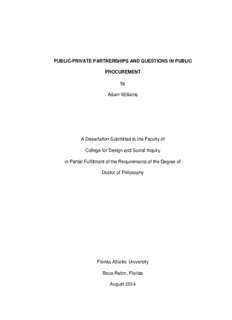
PUBLIC-PRIVATE PARTNERSHIPS AND QUESTIONS IN PUBLIC PROCUREMENT by Adam ... PDF
Preview PUBLIC-PRIVATE PARTNERSHIPS AND QUESTIONS IN PUBLIC PROCUREMENT by Adam ...
PUBLIC-PRIVATE PARTNERSHIPS AND QUESTIONS IN PUBLIC PROCUREMENT by Adam Williams A Dissertation Submitted to the Faculty of College for Design and Social Inquiry in Partial Fulfillment of the Requirements of the Degree of Doctor of Philosophy Florida Atlantic University Boca Raton, Florida August 2014 Copyright by Adam Williams 2014 ii iii ACKNOWLEDGEMENTS The author wishes to acknowledge the National Institute of Governmental Purchasing [NIGP] for their cooperation and support. Their willingness to provide access to their membership played a vital role in the success of this dissertation and will continue to play a role in the advances in research focusing on public procurement. Additionally, the author would like to thank the Public Procurement Research Center at Florida Atlantic University for their assistance in survey administration and collection. Finally, it is with much appreciation that the membership of the dissertation committee is thanked. Their dedication to the advancements within the field and the School of Public Administration program at Florida Atlantic University made this dissertation possible. iv ABSTRACT Author: Adam Williams Title: Public-Private Partnerships and Questions in Public Procurement Institution: Florida Atlantic University Dissertation Advisor: Dr. Hugh Miller Degree: Doctor of Philosophy Year: 2014 This study explores the connections of public procurement official perceptions of public-private partnerships and their contracting decisions for public infrastructure projects. Detailed discussion of previous scholarship and its focus on policymaking and project evaluation of public-private partnerships leaves a gap in the public policy process – implementation. Procurement officials are presented in the role of policy implementers rather than agents in a principal- agent approach. This attempts to address a shortcoming of the description that these officials do nothing more than purchase. Arguments are put forth that these officials are given additional levels of discretion when faced with contracting decisions. Specifically, procurement officials observe that public-private partnerships provide sets of project consequences. v A survey instrument is designed to explore the differences in perceptions that procurement officials have with respect to public-private partnerships and traditional contracting out. Survey failures result in findings only being able to attempt a more general view of public-private partnerships. Results allow perceptions to be placed in a decision-making model based on a project phase approach that develops on the assumption that tasks contracted to private vendors produce project consequences. Furthermore, analysis of significant consequence perceptions indicate that those perceptions do not provide a rationale for a procurement official’s decision-making on whether to contract using a public-private partnership for public infrastructure projects. Independent sample t-tests, controlled correlations, multiple ANOVA and linear regression analyses show that perceptions of consequences, the perceptions of differences of those consequences across project phases, relationships of consequences to perceptions of efficiency and effectiveness proxies and a bounded rationality- based model of decision-making for procurement officials are all inconclusive. Discussion focuses on the development of consequences and phases as defining and clarifying public-private partnerships. Further discussions are presented for procurement officials with respect to their decision-making and possible role as policy implementers. Conclusions fail to uncover any inferential results. The research finds its primary contribution in the conceptual discourse of public procurement official roles and public-private partnership definitions. vi PUBLIC-PRIVATE PARTNERSHIPS AND QUESTIONS IN PUBLIC PROCUREMENT LIST OF TABLES……………………………………………………………………….xi LIST OF FIGURES…………………………………………………………………….xii CHAPTER 1: INTRODUCTION………………………………………………………..1 Overview of the Problem and Research Focus……………………………………...4 Intended Research Questions……...………………………………………….9 Overview of the Methodology, New Research Questions and Hypotheses………………………………………..……………………10 Importance of the Research…………………………………………….........15 Scope of the Study…………………………………………………………….16 Summary and Looking Ahead………………………………………………..17 CHAPTER 2: REVIEWING PARTNERSHIPS………………………...……………20 Previous Literature…………………………………………………………….20 Public Infrastructure…………………………………………………...21 Defining the Undefinable? Public-Private Partnerships……………23 Terms, Terms and More Terms………………………………………28 Seeing the Outcomes of Public-Private Partnership……………….29 Conceptualizing Partnerships and Procurement Decisions……………….34 Discretion in the Eyes of Procurement………………………………35 vii Summary………………………………………………………………….........39 CHAPTER 3: METHODOLOGY……………………………………………………..40 Review of Research Questions and Hypotheses…………………….........40 Model and Assumptions………………………………………………………42 Surveying the NIGP……………………………………………………………45 Data and Variables…………………………………………………………….55 Methods…………………………………………………………………………60 One Independent Sample t-test……………………………………...60 Controlled Pearson’s Correlations…………………………………...61 Multiple Analysis of Variance…………………………………………63 Linear Regression and Assumption Diagnostics…………………...64 Validity…………………………………………………………………….........69 Limitations of Methods………………………………………………………...69 Summary………………………………………………………………….........71 CHAPTER 4: SEEING CONSEQUENCES DIFFERENTLY………………………73 Results from Consequence Perceptions t-tests……………………………74 Planning Phase………………………………………………………...74 Financing Phase……………………………………………………….78 Designing Phase……………………………………………………….81 Building Phase…………………………………………………………82 Operating Phase……………………………………………………….84 Maintaining Phase……………………………………………….........86 Collecting Phase……………………………………………………….88 viii Efficient and Effective Consequences?.....................................................91 Efficiency Results………………………………………………..........92 Effectiveness Results………………………………………………….94 Multiple ANOVA Results………………………………………………………97 Summary………………………………………………………………….......100 CHAPTER 5: PREDICTING PARTNERSHIPS…………………………………...102 Preferring Partnerships?.........................................................................106 Phase In, Phase Out…………………………………………………….......112 Summary………………………………………………………………….......116 CHAPTER 6: HAS ANYTHING BEEN DETERMINED?....................................118 Public-Private Partnership Themes………………………………………...119 Project Consequences………………………………………………120 Project Phases and the Phase Approach………………………….122 Public Procurement Officials………………………………………………..124 Decision-making Process……………………………………….......124 Policymaker-Implementer Relationship……………………………126 Summary………………………………………………………………….......129 CHAPTER 7: FINAL THOUGHTS………………………………………………….131 General Takeaways………………………………………………………….131 Research Limitations………………………………………………………...135 Future Scholarly Endeavors…………………………………………….......137 Summating Thoughts………………………………………………………..139 APPENDICES………………………………………………………………………...141 ix APPENDIX A. IRB APPROVAL…………………………………………….141 APPENDIX B. SURVEY INSTRUMENT…………………………………..142 APPENDIX C. CONSENT FORM…………………………………………..154 APPENDIX D. NONRESPONSE BIAS…………………………………….155 REFERENCES……………………………………………………………………….157 x
Description: